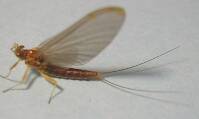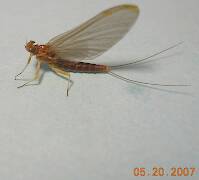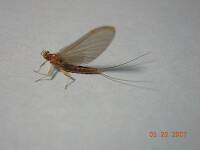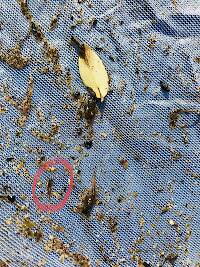
Hex Mayflies
Hexagenia limbata
The famous nocturnal Hex hatch of the Midwest (and a few other lucky locations) stirs to the surface mythically large brown trout that only touch streamers for the rest of the year.
Featured on the forum

This one was surprisingly straightforward to identify. The lack of a sclerite at the base of the lateral hump narrows the field quite a bit, and the other options followed fairly obvious characteristics to Clostoeca, which only has one species, Clostoeca disjuncta.

Troutnut is a project started in 2003 by salmonid ecologist Jason "Troutnut" Neuswanger to help anglers and
fly tyers unabashedly embrace the entomological side of the sport. Learn more about Troutnut or
support the project for an enhanced experience here.
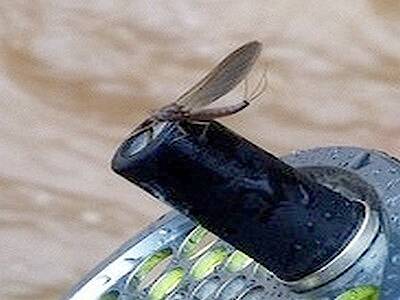
Sandfly on Mar 31, 2012March 31st, 2012, 8:46 am EDT
on going argument about this fly, i say black quill(Leptophlebia cupida) , otheres say blue quill (Paraleptophlebia Adoptiva) what say you ?
sandfly
shop owner
N.J.B.B.A. #2215
Tiadaughton T.U. 688
I didn't Escape------They gave me a day pass !
shop owner
N.J.B.B.A. #2215
Tiadaughton T.U. 688
I didn't Escape------They gave me a day pass !
Troutnut on Mar 31, 2012March 31st, 2012, 9:01 am EDT
It's Paraleptophlebia.
Jason Neuswanger, Ph.D.
Troutnut and salmonid ecologist
Troutnut and salmonid ecologist
Entoman on Mar 31, 2012March 31st, 2012, 9:46 am EDT
Sandfly,
I agree with Jason. The two genera are very similar morphologically, and though your photo doesn't provide the detail necessary to see many characters, L. cupida is a much larger insect and wouldn't usually be found in the kind of water that appears in the background. Also the tails are longer with the terminal filament (middle tail) noticably reduced on cupida. You didn't mention time of year or location, but assuming it's a recent photo and was taken in PA, this is undoubtedly a specimen of P. adoptiva (Blue Quill aka Mahogany Dun). The other Paraleptophlebia possibilities hatch later in the season, several much later.
I agree with Jason. The two genera are very similar morphologically, and though your photo doesn't provide the detail necessary to see many characters, L. cupida is a much larger insect and wouldn't usually be found in the kind of water that appears in the background. Also the tails are longer with the terminal filament (middle tail) noticably reduced on cupida. You didn't mention time of year or location, but assuming it's a recent photo and was taken in PA, this is undoubtedly a specimen of P. adoptiva (Blue Quill aka Mahogany Dun). The other Paraleptophlebia possibilities hatch later in the season, several much later.
"It's not that I find fishing so important, it's just that I find all other endeavors of Man equally unimportant... And not nearly as much fun!" Robert Traver, Anatomy of a Fisherman
Crepuscular on Mar 31, 2012March 31st, 2012, 9:47 am EDT
Looks like Paraleptophlebia to me.
Konchu on Mar 31, 2012March 31st, 2012, 9:53 am EDT
coloration and wing shape are like Paraleptophlebia
Sandfly on Apr 1, 2012April 1st, 2012, 2:31 am EDT
Thanks everyone, just seemed to dark to me..
sandfly
shop owner
N.J.B.B.A. #2215
Tiadaughton T.U. 688
I didn't Escape------They gave me a day pass !
shop owner
N.J.B.B.A. #2215
Tiadaughton T.U. 688
I didn't Escape------They gave me a day pass !
Konchu on Apr 1, 2012April 1st, 2012, 9:27 am EDT
Just to mix things up a bit, and to spark some discussion, I'll throw the North American genera Habrophlebia and Habrophlebiodes into the mix here. In hand, how do you tell the duns of these, and most Paraleptophlebia apart?
Hint: I think one may be a little darker than the others and usually has more of an abdominal colour pattern.
What about wing shapes? Is size important in this instance?
Hint: I think one may be a little darker than the others and usually has more of an abdominal colour pattern.
What about wing shapes? Is size important in this instance?
Entoman on Apr 1, 2012April 1st, 2012, 11:26 am EDT
Luke -
I think we would be going a bit too far in the other direction with those generic possibilities. They're mostly under 5 mm, aren't they? I'm estimating the size of this critter at somewhere in the 7 - 8mm range. It is difficult to go by wing and body characters as the photo is blurry and stretched. If it weren't, I'd be looking closely at the tails and the hind wings for costal projection shape and location (if any) and also the forelegs.
As far as the body color hint, Habrophlebia vibrans (the only species of that genus known for North America) has a unique pattern of white triangles with a dark background on the middle 5 terga. Their opposite 5 ventral segs are almost solid white. Is that what you are referring to?
I suppose the species Leptophlebia johnsoni would have been an option if this specimen were a little larger, as it runs smaller than others in its genus. They can be fairly difficult to tell from larger Paraleptophlebia specimens when the latter approach 10mm.
I think we would be going a bit too far in the other direction with those generic possibilities. They're mostly under 5 mm, aren't they? I'm estimating the size of this critter at somewhere in the 7 - 8mm range. It is difficult to go by wing and body characters as the photo is blurry and stretched. If it weren't, I'd be looking closely at the tails and the hind wings for costal projection shape and location (if any) and also the forelegs.
As far as the body color hint, Habrophlebia vibrans (the only species of that genus known for North America) has a unique pattern of white triangles with a dark background on the middle 5 terga. Their opposite 5 ventral segs are almost solid white. Is that what you are referring to?
I suppose the species Leptophlebia johnsoni would have been an option if this specimen were a little larger, as it runs smaller than others in its genus. They can be fairly difficult to tell from larger Paraleptophlebia specimens when the latter approach 10mm.
"It's not that I find fishing so important, it's just that I find all other endeavors of Man equally unimportant... And not nearly as much fun!" Robert Traver, Anatomy of a Fisherman
Quick Reply
Related Discussions
Topic
Replies
Last Reply
4
Dec 22, 2009
by Oldredbarn
by Oldredbarn
17
Apr 10, 2012
by Entoman
by Entoman
4
Nov 19, 2017
by Btbo32
by Btbo32






